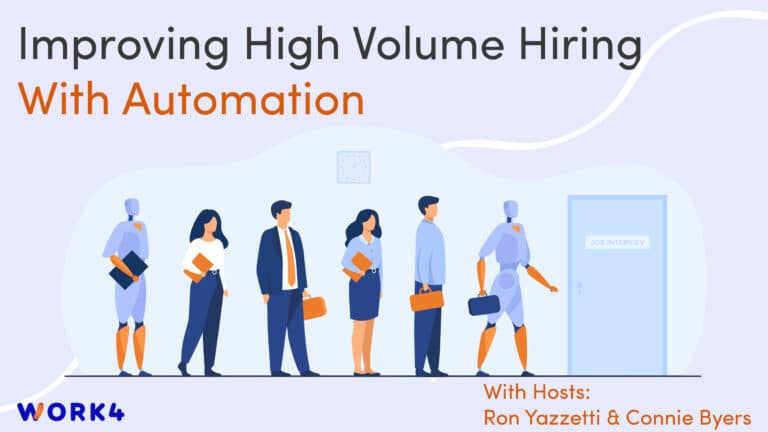It’s a fact of business that in every organization, talent comes and talent goes. And, it’s a common misconception that an unfilled position means your company is saving money. After all, no salary, no benefits, and no payroll must mean more money in the bank, right?
Wrong. When a position is left unfilled, the financial cost can actually be quite high. Not to mention the unplottable costs such as the negative impact on productivity, employee engagement, and team morale. These are factors that are nearly impossible to tie monetary metrics to, but they do still have a cost.
As the talent shortage rages on, the Cost of Vacancy (COV) is estimated to result in $8.5 trillion in unrealized annual revenues and an overall talent shortage of 85 million. With numbers like that, having a clear understanding of COV and being able to communicate its significance to an organization’s bottom line is essential. Particularly when it comes time to articulate the importance of an effective recruitment strategy to upper management.
What is Cost of Vacancy (COV)?
The cost of vacancy (COV) is a measure for calculating the true lost dollar impact when a role is left unfilled. Not to be confused with cost per hire, which is the dollar value you spend filling open roles, COV is used to provide a baseline for the financial impact of an open role.
While it may seem cost-effective to leave a position unfilled to spare your company the costs of salaries, benefits, and overheads, the opposite is true. As we mentioned above, unfilled positions can have a trickle-down effect on the rest of your organization.
Factors in Cost of Vacancy
There are a lot of factors that play into the costs of an unfilled position, below we’ll cover those factors in three main categories.
Hard Costs
Your hard costs are the measurable costs you can directly assign to a vacant position. These include:
- Lost revenue
- Lost sales
- The workload left when a position is vacant
- The cost of overtime while existing staff covers the leftover workload
- It also includes every aspect of hiring to fill the role
- recruitment marketing
- all of the work hours invested in each step of the hiring process
- onboarding and training
- business error rates from a new hire during training
Soft Costs
Your soft costs will be less tangible, but will still need to be factored in. These include:
- Loss or reduction in productivity
- A decline in employee morale
- Reduced customer service quality
- A potential dip in trust in the company’s management
- An increase in burnout as existing employees struggle to cover the duties of the missing employee
Lost Opportunities
Last but not least, companies need to consider the loss of growth opportunities that could be experienced. When you have limited staff, and limited resources it becomes difficult to take advantage of both product and business development opportunities. This can have a large impact on your business’s ability to scale and grow.
How to Calculate Cost of Vacancy
For unfilled revenue-generating roles like sales positions, calculating the COV is a relatively straightforward process. Simply determine the quota that’s not being met while the role remains unfilled.
Determining COV for non-revenue-generating vacancies however is a bit more complex; after all, there is no simple formula to quantify the reduction in productivity, the diminished team morale, or the potential for missed project deadlines. Because of this, the COV for non-sales roles should be seen as a baseline metric for the minimum amount of revenue lost due to a vacant position.
Determine Lost Revenue
First, calculate the amount of revenue lost as a result of the vacant position. To determine the average employee revenue for your organization, divide the company’s annual revenue by the total number of employees in the organization. Then, multiply that number by the average number of working days per year (260), to determine the daily employee revenue.
- Example:
LMNOP Foods just lost one of its top production line workers. The individual was compensated $30,000 annually, and the company anticipates the time-to-fill will be 36 days. LMNOP Foods has 225 employees and brings in $14M in revenue. - (Annual revenue) / (Number of Employees) = Average employee revenue
$14,000,000 / 225 = $62,222 - (Average employee revenue) / (260 working days/year) = Daily employee revenue
$622,22 / 260 = $239.32 per day
Calculate Role-Specific Revenue
Next, estimate a specific role’s revenue by utilizing a predetermined multiplier, which helps quantify revenue based on the role’s specific level of impact on the company.
- Multiply the daily salary by one for a vacant entry-level or hourly position
- Multiply by two for high-impact roles like sales staff or tech employees
- Multiply the daily salary by three for executive and leadership roles
Keep in mind that these are general guidelines, and you may need to talk to your finance team to determine the exact level of impact for a specific role.
- (Avg. daily employee revenue) x (Revenue-impact multiplier) = Daily role-specific revenue
$239.32 x 1 = $239.32
Calculate Revenue Lost to the Vacant Role
Finally, multiply the daily role-specific revenue by the estimated time-to-fill. Currently, LinkedIn estimates the average time to fill at 36 days.
- Example:
(Daily role-specific revenue) x (Estimated time-to-fill) = Revenue lost to vacant role
$239.32 per day x 36 days = $8,615.53
At a length of 36 days to fill, this open position will cost LMNOP Foods $8,615.53 in lost revenue.
Determine Cost Savings From a Vacant Roll
On the other hand, there will be some payroll and benefit savings when a role is unfilled.
Calculate the Cost of an Employee
According to the Bureau of Labor Statistics, on average, employee benefits cost 31.4 percent of an employee’s annual salary. Calculate the cost of the employee by adding the employee’s salary and the cost of benefits.
- Example:
(Employee salary) x (.314) = Cost of benefits
$30,000 x .314 = $9,420 - (Employee salary) + (Cost of benefits) = Cost of employee
$30,000 + $9,420 = $39,420
The LMNOP Foods production line worker’s benefits cost the company $9,420 annually. In total, the line worker costs LMNOP Foods $39,420 per year.
Calculate Payroll and Benefits Savings
Next, let’s calculate the payroll and benefits savings during the period of vacancy. To do this, first, determine the daily cost of the employee by dividing the cost of the employee by 260. Then, multiply that value by the estimated time-to-fill, or the number of days the role is expected to remain open.
- Example:
(Cost of employee) / 260 = Daily cost of employee
$39,420/260 = $151.62 - (Daily cost of employee) x (Estimated time-to-fill) = Payroll/benefits savings
$151.62 x 36 = $5,458
Calculate the Cost of Vacancy
Now, we can calculate the cost of vacancy by subtracting the revenue lost from the payroll and benefits savings.
- Example
(Payroll and benefits savings) – (Revenue lost to the vacant role) = cost of vacancy
$5,458 – $8,615.53 = $3,157.53
In the end, a vacant production line role will save LMNOP foods $5,458 but cost them $8,615.53 meaning that for each open production line roll LMNOP Foods will lose $3,157. 53 due to the unfilled role.
Keep in mind that this value is simply a baseline or the minimum amount of revenue that an open role will cost you— you’re losing a lot more than that. The actual impact of vacancy on your organization will also need to factor in productivity loss, project delays, declining employee morale, employee burnout due to increased workloads, and more.
Conclusion
As you can see, It’s easy to calculate the hard costs associated with leaving a job vacant. However, it can be challenging to measure the soft costs that don’t come with a simple monetary value. To arrive at your organization’s true cost of vacancy, you will need to factor in the intangible costs as well.
But, knowing how to calculate the monetary cost of leaving positions vacant will help you realize how much your company is losing when a role is left unattended.
If you need help filling those vacant positions, use the form below to schedule a meeting with one of the pros at Work4 today to discuss how we can help you hire in “fast motion.” With on-demand sourcing and recruitment automation, our platform can reduce your time to fill by 50% or more! Contact us, to find out how.





